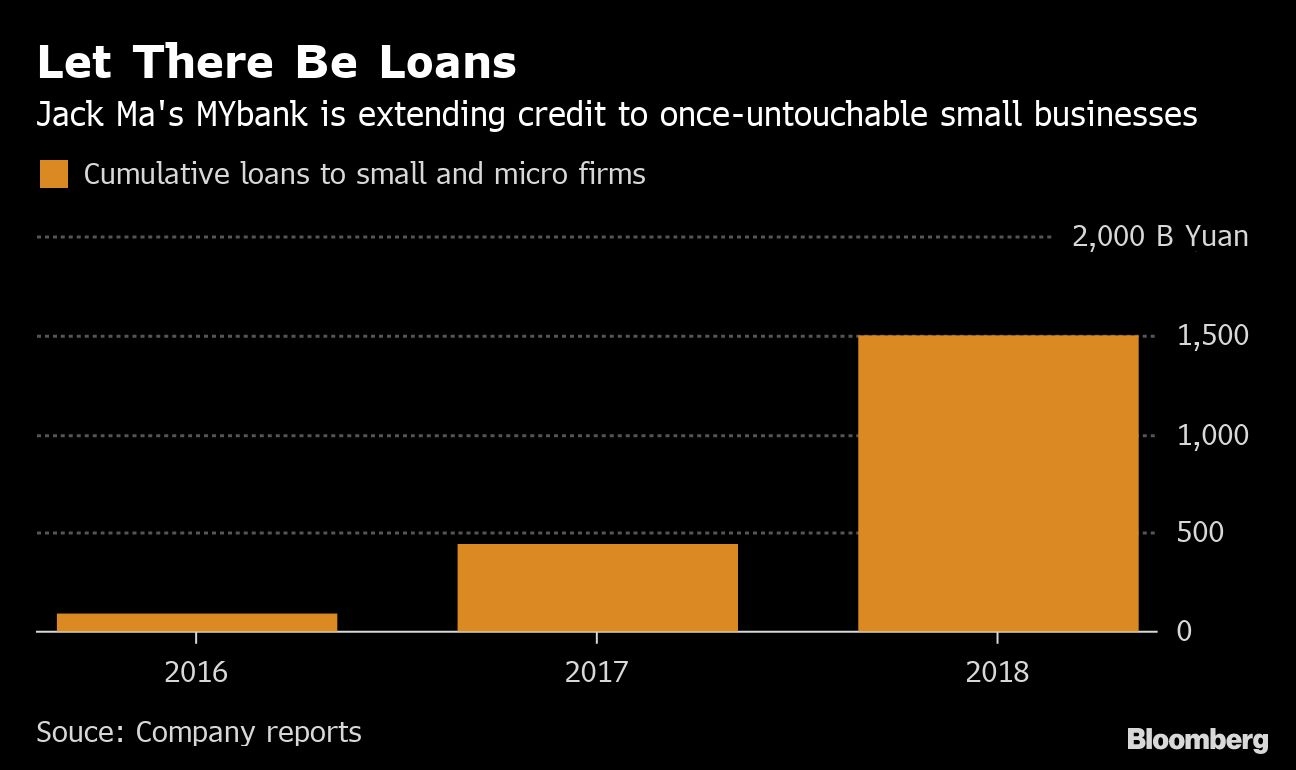Jul 27, 2019
Jack Ma's US$290-billion loan machine is changing Chinese banking
Bloomberg News

Jack Ma’s online bank is leading a quiet revolution in the way China lends to small businesses, taking aim at a credit bottleneck that has held back Asia’s largest economy for decades.
Using real-time payments data and a risk-management system that analyzes more than 3,000 variables, Ma’s four-year-old MYbank has lent 2 trillion yuan (US$290 billion) to nearly 16 million small companies. Borrowers apply with a few taps on a smartphone and receive cash almost instantly if they’re approved. The whole process takes three minutes and involves zero human bankers. The default rate so far: about 1 per cent.
The financial-technology boom that turned China into the world’s biggest market for electronic payments is now changing how banks interact with companies that drive most of the nation’s economic growth. As MYbank and its peers crunch reams of new data from payment systems, social media and other sources, they’re growing more comfortable with smaller borrowers that they previously shunned in favor of state-owned giants.
For China’s US$13 trillion economy, which expanded at its weakest pace since at least 1992 last quarter, the implications could be profound. Non-state firms -- mostly small businesses -- account for about 60 per cent of growth, employ 80 per cent of workers, and have been disproportionately squeezed by a more than two-year government crackdown on shadow lenders.

“Small and medium enterprises are really the boiler room of the economy,” said Keith Pogson, global assurance leader for banking and capital markets at Ernst & Young based in Hong Kong. “It used to be a segment that banks thought was too difficult and too risky. But now they run their model and work out what the risks are so they feel more comfortable.”
China is quickly becoming a world leader in the use of big data and artificial-intelligence technology to make loans, according to Cliff Sheng, co-head of Greater China financial services at Oliver Wyman, a consulting firm. Among the country’s biggest advantages: it takes a more relaxed approach toward privacy than many other jurisdictions.
“Our legal framework and regulatory environment -- which raise fewer privacy concerns -- make it easier to generate a huge amount of data and thus provide an unparalleled testing bed,” Sheng said.
One uniquely Chinese source of information for banks is the controversial social credit system, which is being tested in cities across the country as a way to reward good deeds and punish misbehavior. In one potential scenario cited by MYbank President Jin Xiaolong in a recent interview, a small-business owner whose social credit score dropped because he failed to return a borrowed umbrella would find it harder to get a loan.
But the biggest data trove may come from payments providers like the one operated by Ma’s Ant Financial, the biggest shareholder of MYbank. After obtaining authorization from borrowers, MYbank analyzes real-time transactions to gain insights into creditworthiness. For example, a drop in customer payments at a retailer’s flagship store might be an early indicator that the company’s prospects -- and its ability to repay debt -- are deteriorating.
The upshot of more information is a loan approval rate at MYbank that’s four times higher than at traditional lenders, which typically reject 80 per cent of small-business loan requests and take at least 30 days to process applications, according to Jin, who plans to double MYbank’s roster of borrowers in three years. He said the Hangzhou-based firm’s operating cost per loan is about 3 yuan, versus 2,000 yuan at traditional rivals.
MYbank, which earned 670 million yuan last year, is far from the only lender using technology to boost small-business lending. Units of Tencent Holdings Ltd. and Ping An Insurance Group Co. both have similar offerings, while state-owned China Construction Bank Corp. is dramatically ramping up its presence in the space.
The nation’s second-largest lender unveiled a mobile app in September that can process loan applications for as much as 5 million yuan in two minutes. Construction Bank boosted its small-business lending by 51 per cent last year, more than twice as fast as the industry. The bank charges an average interest rate of 5.3 per cent for one-year loans, slightly above the 4.35 per cent benchmark lending rate, and says defaults have held at a minuscule 0.3 per cent.
“It’s a profitable business as long as you can keep the risks in check,” said Zhang Gengsheng, a vice president at Construction Bank in Beijing. “We had suffered huge losses in the past with a bad-loan ratio running at 8 per cent. But now we’re back in the game.”
While keeping defaults in check may prove more difficult as China’s economy slows, all signs point toward continued growth in small-business lending. In February, the banking regulator called on state-owned lenders to boost credit to small companies by at least 30 per cent this year. MYbank is looking to raise about 6 billion yuan, which will more than double its capital to 10 billion yuan and allow it to boost lending, people familiar with the matter said on Monday.
About two-thirds of the country’s 80 million small businesses lacked access to loans as of 2018, according to China’s National Institution for Finance & Development.
For Zeng Ping’en, who runs a scooter store in Hangzhou with about 1.2 million yuan in annual sales, MYbank’s lending app has been a game changer. After allowing the bank to access his store’s transaction data, Zeng has been able to take out small loans to cover short-term cash needs. He pays an annualized interest rate of about 15 per cent.
“It was unimaginable a few years ago, when no bank would approve my request,” Zeng said. “Now I can borrow whenever I need to.”
--With assistance from Zhang Dingmin







